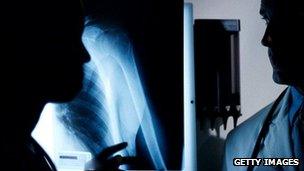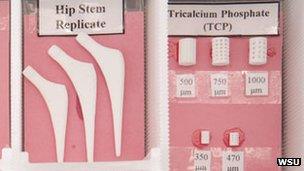Engineers pioneer use of 3D printer to create new bones
- Published

The team say doctors should be able to order custom-built bone scaffolds within the next few years
A 3D printer is being used to create "bone-like" material which researchers claim can be used to repair injuries.
The engineers say the substance can be added, external to damaged natural bone where it acts as a scaffold for new cells to grow.
It ultimately dissolves with "no apparent ill-effects", the team adds.
The researchers say doctors should be able to use the process to custom-order replacement bone tissue in a few years time.
Prof Susmita Bose helped carry out the work at Washington State University and co-authored a report in the Dental Materials journal.
"You can use the bone-like ceramic powder as a feed material and it can make whatever you draw on the computer," she says.
"It is mostly [suitable for] low load bearing applications. However, what we are trying to develop is the controlled degradation... of these scaffolds where as the scaffold dissolves in the body the bone tissue grows over it."
Binder
Prof Bose's team have spent four years developing the bone-like substance.

Prof Bose hopes the material will be used for orthopaedic and dental work
Their breakthrough came when they discovered a way to double the strength of the main ceramic powder - calcium phosphate - by adding silica and zinc oxide.
To create the scaffold shapes they customised a printer which had originally been designed to make three-dimensional metal objects.
It sprayed a plastic binder over the loose powder in layers half as thick as the width of a human hair.
The process was repeated layer by layer until completed, at which point the scaffold was dried, cleaned and then baked for two hours at 1250C (2282F).
Repairs
Tests carried on immature foetal bone cells in the laboratory found that new bone cells started growing over the scaffold within the first week of it being attached.
The team say they have also had promising results from tests involving live rabbits and rats.
"The way I envision it is that 10 to 20 years down the line, physicians and surgeons should be able to use these bone scaffolds along with some bone growth factors, whether it is for jaw bone fixation or spinal fusion fixation," says Dr Bose.

The US-team believe that the substance they have created does not pose any health risks
This is not the first time that orthopaedic experts have investigated the use of 3D printers.
Earlier this year a surgical trainee at Scotland's Monklands hospital detailed a technique to produce bone replicas using the technology.
Mark Frame suggested using a CAT scanner to produce images of damaged bones.
He said the data could then be fed into a 3D printer to create a model to help doctors plan their surgery.
He said the process cost about a tenth of traditional techniques.
- Published28 November 2011
- Published2 September 2011
- Published21 February 2011
- Published25 November 2010